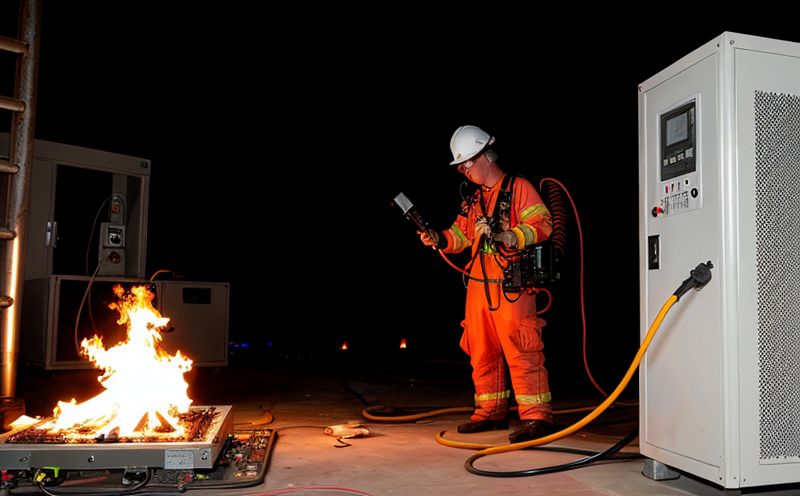Fire Resistance Testing for Electric Vehicle Charging Equipment
The demand for electric vehicle (EV) charging infrastructure has grown exponentially, driven by environmental concerns and government incentives. As the number of EVs increases, so does the importance of ensuring that their charging equipment is safe from fire hazards. Fire resistance testing plays a critical role in guaranteeing this safety.
Fire resistance testing assesses how well an electrical or electronic device can withstand exposure to flames without sustaining damage severe enough to compromise its integrity or functionality. For electric vehicle charging equipment, this means evaluating the ability of the charger and associated components to maintain safe operation under fire conditions. This is especially important given that EV chargers are often installed outdoors and may be exposed to various environmental factors.
The testing process involves exposing a sample of the charging equipment to controlled fire conditions in accordance with relevant international standards such as IEC 60364-7-52, which provides guidelines for fire resistance tests on electrical installations. The test aims to determine if the charger can retain its structural integrity and functional performance after exposure.
During testing, careful attention is paid to the specimen preparation. This includes ensuring that all components are assembled correctly according to manufacturer specifications before being subjected to the flame. Once exposed, the equipment’s ability to maintain stability and functionality is monitored closely by experienced personnel using state-of-the-art instrumentation. The test concludes with a detailed report outlining any observed failures or performance issues.
Understanding the implications of fire resistance testing for electric vehicle charging equipment helps stakeholders appreciate its significance. By conducting this type of evaluation, manufacturers can ensure their products meet stringent safety requirements and contribute to safer public spaces where EVs are used.
Why Choose This Test
Selecting fire resistance testing for electric vehicle charging equipment offers numerous benefits that extend beyond mere compliance. It enhances product reliability and durability, which is crucial given the demanding operating environments of EV chargers. Moreover, it fosters trust among consumers by demonstrating a commitment to safety standards.
- Ensures adherence to international fire resistance standards such as IEC 60364-7-52.
- Promotes reliability and durability of the charging equipment under adverse conditions.
- Fosters consumer confidence through demonstrated commitment to safety standards.
By choosing this testing service, organizations not only meet regulatory requirements but also position themselves as leaders in innovation and safety. This proactive approach can lead to increased market share and better customer satisfaction.
Competitive Advantage and Market Impact
Incorporating fire resistance testing into the development process of electric vehicle charging equipment provides significant competitive advantages. It sets a benchmark for quality that differentiates products in an increasingly crowded market. Demonstrated compliance with rigorous standards like IEC 60364-7-52 can be leveraged to attract discerning buyers who prioritize safety and reliability.
Furthermore, successful completion of fire resistance tests enhances brand reputation, making it easier for companies to establish long-term relationships with customers. A robust safety record also opens doors to new markets where stringent quality controls are enforced. By investing in this testing service early on, businesses can anticipate future challenges and stay ahead of competitors.
Market impact is substantial; consumers increasingly demand products that meet high safety standards. Companies that demonstrate proactive measures towards ensuring these standards will likely see growth in market share and customer loyalty.
Use Cases and Application Examples
- Outdoor Installation: Ensuring that EV chargers installed outdoors can withstand potential fire hazards from nearby structures or accidental ignition sources.
- Indoor Parking Facilities: Evaluating the safety of charging equipment within enclosed spaces where fires could spread rapidly.
- Rural Areas: Assessing how charging stations in remote locations might perform under extreme weather conditions which can exacerbate fire risks.
- Urban Environments: Testing the resilience of city-based chargers to withstand accidental fires or other emergencies that could occur within their vicinity.
These examples illustrate the broad applicability of fire resistance testing across various settings. By addressing these scenarios, manufacturers can create charging solutions that are robust enough to handle real-world challenges effectively.





